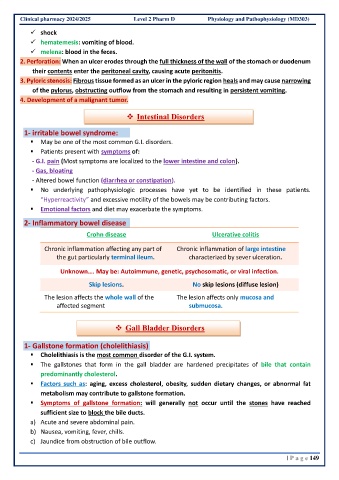Page 215 - Physiology and Pathophysiology MNU 2024-2025 نظرى
P. 215
Clinical pharmacy 2024/2025 Level 2 Pharm D Physiology and Pathophysiology (MD303)
✓ shock
✓ hematemesis: vomiting of blood.
✓ melena: blood in the feces.
2. Perforation: When an ulcer erodes through the full thickness of the wall of the stomach or duodenum
their contents enter the peritoneal cavity, causing acute peritonitis.
3. Pyloric stenosis: Fibrous tissue formed as an ulcer in the pyloric region heals and may cause narrowing
of the pylorus, obstructing outflow from the stomach and resulting in persistent vomiting.
4. Development of a malignant tumor.
❖ Intestinal Disorders
1- irritable bowel syndrome:
▪ May be one of the most common G.I. disorders.
▪ Patients present with symptoms of:
- G.I. pain (Most symptoms are localized to the lower intestine and colon).
- Gas, bloating
- Altered bowel function (diarrhea or constipation).
▪ No underlying pathophysiologic processes have yet to be identified in these patients.
“Hyperreactivity” and excessive motility of the bowels may be contributing factors.
▪ Emotional factors and diet may exacerbate the symptoms.
2- Inflammatory bowel disease
Crohn disease Ulcerative colitis
Chronic inflammation affecting any part of Chronic inflammation of large intestine
the gut particularly terminal ileum. characterized by sever ulceration.
Unknown…. May be: Autoimmune, genetic, psychosomatic, or viral infection.
Skip lesions. No skip lesions (diffuse lesion)
The lesion affects the whole wall of the The lesion affects only mucosa and
affected segment submucosa.
❖ Gall Bladder Disorders
1- Gallstone formation (cholelithiasis)
▪ Cholelithiasis is the most common disorder of the G.I. system.
▪ The gallstones that form in the gall bladder are hardened precipitates of bile that contain
predominantly cholesterol.
▪ Factors such as: aging, excess cholesterol, obesity, sudden dietary changes, or abnormal fat
metabolism may contribute to gallstone formation.
▪ Symptoms of gallstone formation: will generally not occur until the stones have reached
sufficient size to block the bile ducts.
a) Acute and severe abdominal pain.
b) Nausea, vomiting, fever, chills.
c) Jaundice from obstruction of bile outflow.
| P a g e 149

